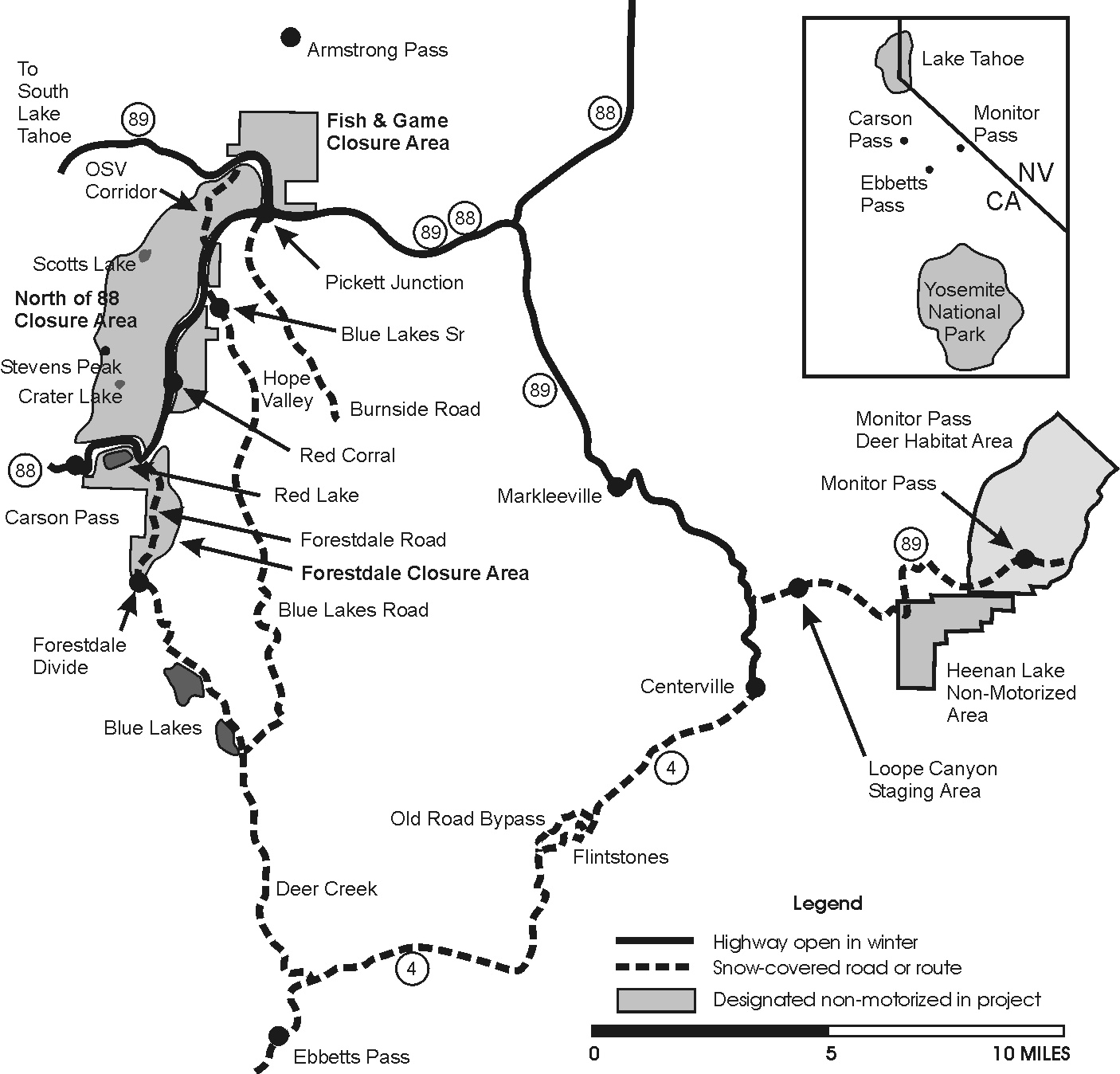Past Project:
Alpine County Winter Recreation Project
Note: The Alpine County Winter Recreation Project is an ongoing issue. Click here for the current status.
The Forestdale Creek area, to the southeast of Carson Pass, has great historical significance to backcountry skiers and snowwhoers. This was a mecca for quiet, non-motorized sports offering beginner terrain along a road and in a meadow, and more advanced terrain going up to Forestdale Divide. In mid-winter, the north-facing bowl at the head of Forestdale Creek offers accessible deep powder skiing. In spring the corn-snow and variety of terrain are outstanding.
The story begins in the 1980s when snowmobiles zoomed up, down, and around Blue Lakes Road and the valleys it passes through. Nearby skiers toured the canyon and slopes of Forestdale Creek, located a short distance to the west. The division between sports was maintained in part because snowmobiles did not have the power to track through the deep snow that was often found at Forestdale and the demand for snowmobiling was met in Hope, Faith, and Charity valleys and on the nearby slopes. There was no regulation separating the uses.
The 1990s brought more snowmobiles with more powerful engines and more skillful riders. Riders could get places it is hard to imagine taking a 500 or 600 pound machine. At the same time backcountry skiing saw growth as wide skis with greater side-cut made cranking turns in the backcountry easier and more fun. Telemark skiing was born. Also, by the late 1990s snowshoeing had taken off as a sport. Lightweight aluminum snowshoes designed specifically for snowshoers of all sizes and featuring improved bindings made striking out into the winter backcountry easy for anyone who could hike. Almost overnight snowshoeing became the fastest growing winter sport on many forests.
The clash came as snowmobilers found their way into the Forestdale Creek drainage. The canyon was permeated by the chainsaw-like sounds of snowmobiles grinding up slopes, and in short-order the machines would tear-up the snowscape making it unsuitable for skiing and an eyesore for the nature lover.
In March 1997, after many attempts to work with the Forest Service, skiers challenged the 1992 Carson Ranger District Travel Plan in court. The legal challenged ended in a settlement in which the Forest Service agreed to do a new travel plan for the Forestdale Creek area.
The new Forestdale Creek Travel Plan was as flawed as the original, and in September 2000 a lawsuit was filed challenging it. Court-ordered settlement talks delayed the lawsuit, but in September 2004 Judge David Levi remanded the Travel Plan to the Forest Service, thus requiring a third plan to be undertaken.
The Forest Service chose to include the Forestdale Creek area in a more far-reaching winter recreation plan: the Alpine Winter Recreation Project. The Forest Service hoped that by expanding the scope of the planning there would be the opportunity to provide improved muscle-powered and motorized winter recreation.
The public planning process was preceded by meetings at which muscle-powered winter recreationists, environmentalists, and snowmobilers created what some would call a balanced plan under which both user groups would benefit. The groups were forced to set their priorities and give and take based on them. The meetings included a professional facilitator who kept the process on track.
In February 2007 the Forest Service did public scoping on the issue and in May 2007 issued a Notice of Proposed Action that included the concept created by the user groups. In August 2007 District Ranger Gary Schiff, as one of his final acts before moving to a new job in Washington, DC, issued the Environmental Assessment and signed the Decision and Finding of No Significant Impact thereby making the Alpine Winter Recreation Project official.
Marcus Libkind, Snowlands Network President, who had been involved in the Forestdale Creek issue with others for 17 years said, “We now have a plan that is not perfect but could be the basis for improved winter recreation for all in Alpine County. Both sides had to make difficult choices. Both sides got some things they wanted and simultaneous had to give in other areas.”
The major components of the final Project that benefited the non-motorized community included:
- Forestdale Closure – Winter non-motorized designation for the Forestdale Creek area for most of the snow season. This is located just east of Carson Pass on Highway 88.
- North of Highway 88 Closure – Winter non-motorized designation for the lands on the north side of Highway 88 that include Stevens Peak, Crater Lake and Scotts Lake. This is located between Carson Pass and Pickett Junction on Highway 88.
- Red Corral Parking Area – Parking on Highway 88 in Hope Valley for access to designated non-motorized area.
On the other side, the snowmobile community benefits included:
- Improved access to the Monitor Pass area.
- Improved access to the Highway 4 corridor.
- Expansion of parking at Blue Lakes Road that includes overnight facilities.
The Project was adopted but not funded. As a result it is a continuing project for Snowlands Network.
Click here for an improved quality Alpine County Winter Recreation Project map


